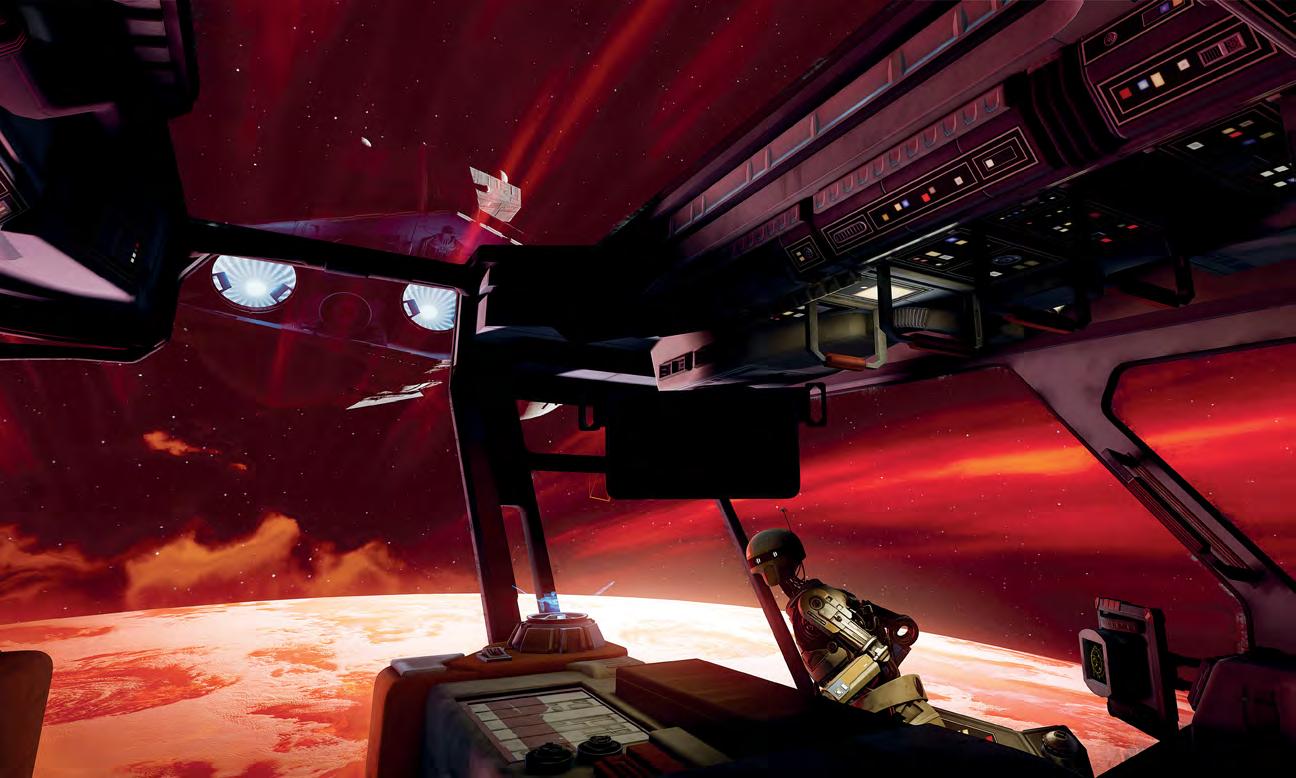TV
THE MANDALORIAN AND THE FUTURE OF FILMMAKING By IAN FAILES
All images copyright © Lucasfilm Ltd. TOP: Pedro Pascal as the Mandalorian and Misty Rosas as Kuiil (voiced by Nick Nolte) in The Mandalorian. OPPOSITE TOP: Director Deborah Chow on the Razorcrest set. OPPOSITE BOTTOM: Kuiil rides atop a CG blurrg.
38 • VFXVOICE.COM SPRING 2020
Two extraordinary things happened when Disney+’s The Mandalorian began airing on the new streaming service. First, the world fell in love with the phenomenon that is Baby Yoda. And second, the world probably did not realize that when the show’s characters appeared on some alien landscape, what they in fact were often watching were actors performing against giant LED screens. The production, from Lucasfilm and Jon Favreau’s Golem Creations, is the first-ever Star Wars live-action television series, and has perhaps already changed the game in terms of what might be possible in live-action TV. This is because of the virtual production approach to filming the show, in which those LED screens displayed real-time-rendered virtual sets that could be changed on the fly. The idea for such an approach was championed by Favreau, the show’s creator and the writer of several episodes, who already had extensive experience with virtual production filmmaking techniques and real-time rendering on projects such as The Jungle Book and The Lion King. The Mandalorian Visual Effects Supervisor Richard Bluff, who hails from Industrial Light & Magic, which oversaw the VFX effort and collaborated with several virtual production vendors, says that it was Favreau who recognized a new approach to shooting a sprawling live-action Star Wars series was needed, and that LED screens and a real-time-rendered environments shooting methodology could be the answer. Among many other benefits, the approach offered the opportunity to not have to rely solely on blue or greenscreens, but instead
have the actors and filmmakers see and interact directly with their environments and even be filmed for in-camera VFX shots. Not only that, since what was displayed on the LED walls was rendered in real-time, the imagery could move in unison with the camera (or performer) and adjust to the appropriate parallax during shooting. Bluff notes that this ‘Volume’ filmmaking helped in many ways, one of which was achieving scope. “One of the biggest challenges with a live-action Star Wars TV show is the number planets and other worlds we visit,” says the VFX Supervisor, who adds that the number of different exotic locations visited in the show would have necessitated the construction of multiple sets or required extensive – and expensive – location shoots around the world. Instead, most of The Mandalorian was captured on shooting stages in Los Angeles. “One of the reasons we wanted to shoot against the LED screens,” Bluff says, “is that we could store all those environments on a hard drive and then load them all up on the screen while giving the actors a minimal – relative to most productions – ‘physical’ set to interact with. “Also,” continues Bluff, “if we hadn’t done it the usual way, what we’d end up with is, say, 180 degrees of 40-foot-tall bluescreens. The challenge with that, of course, is that the actors don’t know where they are. And then when you get into editorial, you can get lost pretty quickly. Actually, [Lucasfilm President] Kathy Kennedy was visiting us in the first few weeks of shooting, and I asked her what she felt was going to be the biggest difference for her personally by shooting with the LED walls. She said it was going to be the ability to follow the storyline without getting distracted by all the bluescreen and questioning where the scene was taking place.”
“One of the reasons we wanted to shoot against the LED screens is that we could store all those environments on a hard drive and then load them all up on the screen while giving the actors a minimal – relative to most productions – ‘physical’ set to interact with.” —Richard Bluff, Visual Effects Supervisor, ILM
SPRING 2020 VFXVOICE.COM • 39















